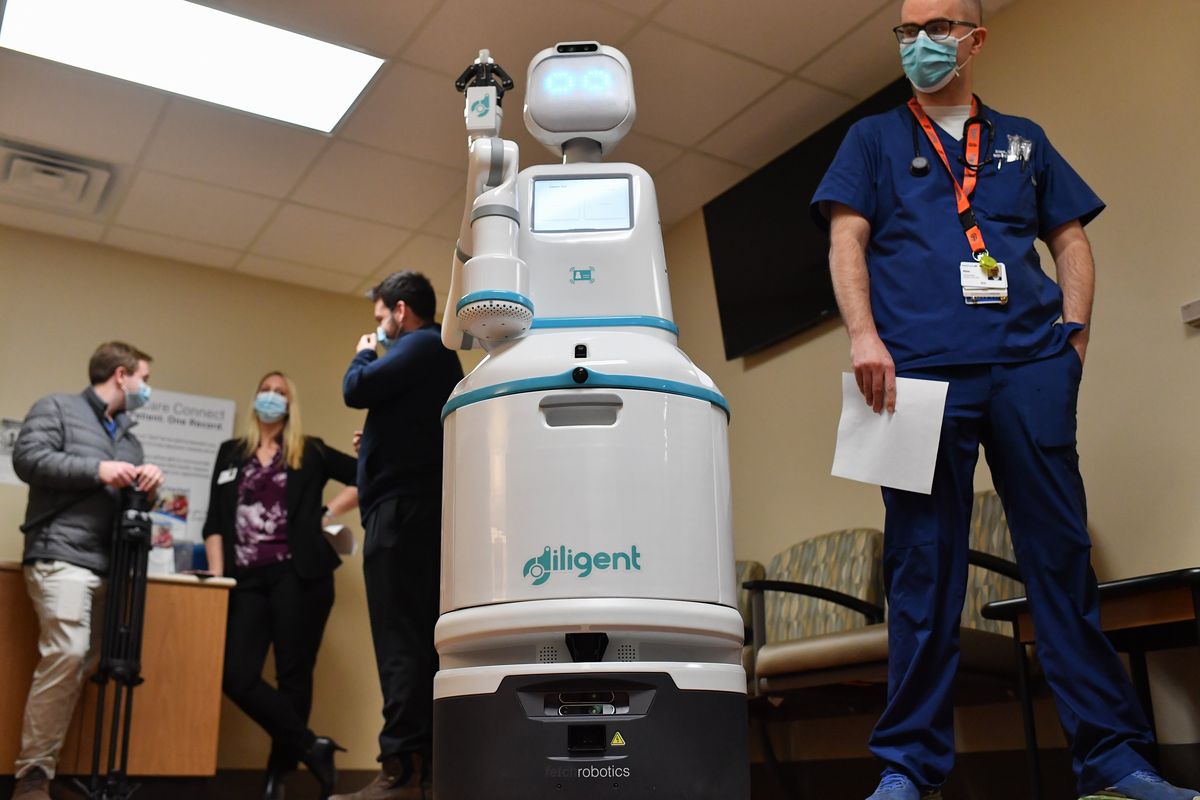Deaconess rolls out nurse robots amid staff shortages to deliver medications, lab work, supplies

Moxi might flash heart-shaped eyes when a nurse gets a delivery of gowns.
At 4 feet, 6 inches tall, the robot rolls self-propelled around the hallways of MultiCare Deaconess Hospital, but only goes to the stations where it’s commanded to be by nurses who ask for the unit’s help through an app.
MultiCare Health Systems on Thursday deployed four of the Moxi units at Deaconess as errand-runners. The “nurse robots” won’t interact with patients or go into their rooms but rather will do basic chores normally handled by nurses, from delivering lab samples and PPE supplies to picking up a patient’s medicine.
Such tasks fill up about 45 to 75 minutes per shift, and they take away from patient care, said Jennifer Graham, chief nurse executive.
“When there is a job to do, a nurse will do it if that means going to the lab or to the pharmacy to get something for a patient,” Graham said. Such errands often require a walk to different areas of the hospital. “We refer to these tasks as pebbles in the shoe; they diminish the amount of time a nurse gets to spend with the patient.”
With the robots doing the footwork, nurses will have more time to do health education with patients, along with care that uses critical thinking skills, Graham said. They’ll have more minutes to mentor and train other staff.
In the first two hours of work Thursday, the robots had completed 24 tasks, said MultiCare spokesman Kevin Maloney, who described the units’ importance as the health industry nationwide grapples with a nurse shortage.
“We know that adding four robots isn’t going to be a magic bullet to cure our ailments of nurse shortages, but I think they’re a good example of some innovations we’re trying,” Maloney said.
“Instead of a nurse having to run from one end of the hospital to the other for PPE or for a prescription medicine, now the robot will be able to do that. It’s been communicated clearly that they’re not taking the place of a nurse or a CNA.”

Austin, Texas-based manufacturer Diligent Robotics designed Moxi specifically for hospitals. The company began distributing them in 2020 and now has more than 40 Moxi units in different U.S. hospitals.
Both Diligent representatives and Maloney said the robots at Deaconess are the first in the state and Pacific Northwest.
The Moxi unit costs are contract-based, so the robots aren’t purchased as a capital expense, Maloney said. “In terms of the cost, we are not at liberty to share the financial details of our contract.”
Moxi talks in short phrases and has sensors that detect people and any obstacles to move around. The robots won’t go into patient rooms, Maloney said.
Graham said Deaconess will roll out different workstream tasks sequentially. The first focuses will be on having the robots pick up and deliver patient lab specimens and then also pick up and deliver medical supplies not typically on a floor, such as specialized dressings stored at a central supply area.
At least three of the robots are likely to be in use at any given time. They will go to charging stations between uses.
Each model has a large drawer in the front and two drawers in the back. Only a hospital employee using a badge can unlock one of Moxi’s drawers for a delivery.
“Then, eventually, Moxi will also do the pickup and delivery of cardiac monitor boxes for patients,” Graham said. “Moxi will do dietary service delivery, probably not the whole tray, but if we missed a milk or a person needs a Jell-O.”
Another task slowly added in will be robot trips to the hospital pharmacy to retrieve medicines and deliver them to a nurse station. Health care workers still control the eight steps taken to validate medication for a patient, she said.
She said the Moxi destinations are mapped out. It has a camera, which doesn’t record, but helps the unit navigate, and for Diligent support in Texas to see the robot’s view in real-time to troubleshoot.
“The robotic arm presses the elevator buttons,” Graham said, and it activates pads that open doors.
“There is a landing spot that’s been pinned for Moxi to stop and she announces a delivery,” she said. “The nurse goes to Moxi and uses a badge to get the delivery. Moxi has three drawers so she can multitask if it fits into the delivery patterns.
“She makes sweet little sounds like a cat, or she says, ‘I’m here for a delivery.’” The phrases are short, so Moxi doesn’t engage in back-and-forth conversations.
Some Deaconess nurses have trained with Moxi for the past several weeks, but it takes only about 15 minutes for an employee to learn how to use the robot, Graham said.
Nurse Dana Oswald, on the medical surgical floor, has seen the Moxi in action.
“I think it’s pretty cool,” Oswald said. “A nurse in the hospital on average walks about 10,000 steps a day. It can save us some of those steps and keep us more at the bedside for direct patient care.”
Lab technicians can’t draw on every patient, such as around specialized equipment and tubes, so a nurse will get the blood samples and often runs them to the lab. The pharmacy is in another area.
Moxi will be able to ease the load – and some stress, Oswald said.
“It’s just there to assist so we can spend more time with our patients, and we’re not running around doing errands and tasks that take us away,” she said. “That means higher-quality care. We’re devoting more time to assessing patients and making sure all their needs are met.
“It is challenging. We have patients who have complex surgeries with drains and tubes, IVs and oxygen. It’s very busy, so anything to help keep us at bedside is going to be extremely helpful.”